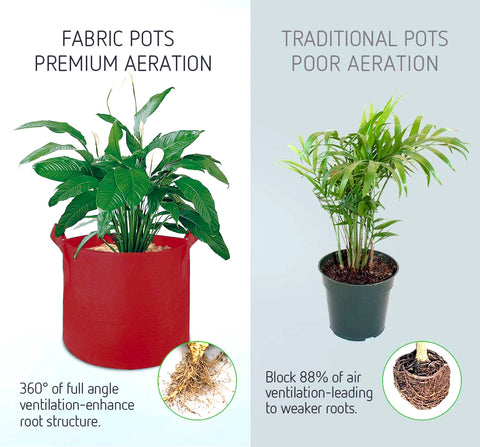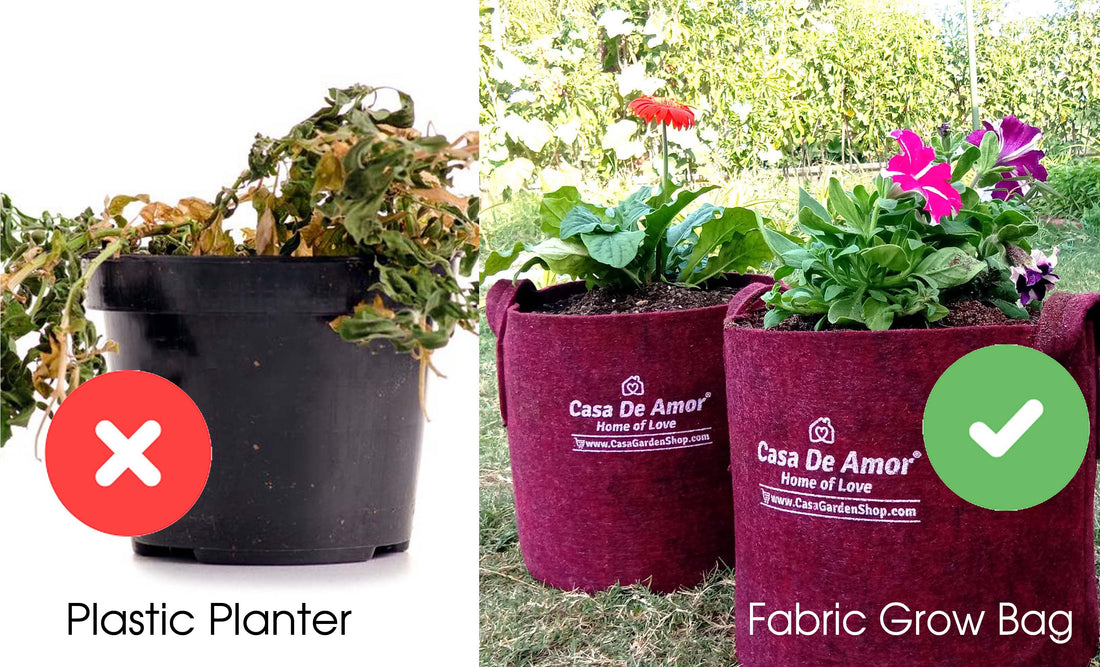There are some key differences between plastic planters and fabric grow planters that may impact your plant's growth and health:
- Water drainage: Fabric grow planters generally have better drainage than plastic planters. The porous material allows for excess water to drain through, preventing over-watering and waterlogging the roots. In contrast, plastic planters can trap water in the soil, leading to root rot.
- Aeration: Fabric grow planters allow for better aeration, as the porous material allows air to flow freely through the soil. This can prevent soil compaction and promote healthier root growth. Plastic planters, on the other hand, may restrict airflow, leading to stagnant soil and poor root health.
- Heat retention: Plastic planters may retain more heat than fabric grow planters, which can be beneficial in cooler climates or for heat-loving plants. However, in hot climates or for plants that prefer cooler temperatures, fabric grow planters may be a better choice as they allow for better air circulation and can keep the soil cooler.
- Durability: Plastic planters are generally more durable than fabric grow planters, as they are less susceptible to tearing or damage from weather conditions. However, fabric grow planters can last several seasons with proper care and storage.
- Cost: Fabric grow planters are generally more expensive than plastic planters, but they can be reused multiple times and may offer better results for some types of plants.
- Size and shape: Plastic planters are often available in a wider range of sizes and shapes than fabric grow planters, which can make them a better choice for specific plants or spaces. For example, if you're looking for a very large planter or a long, narrow window box, you may have more options with plastic planters.
- Appearance: Plastic planters can come in a variety of colors and finishes, from bright and glossy to muted and matte. They can also be molded into a range of shapes and textures, such as faux terra cotta or stone. Fabric grow planters, while generally more simple in appearance, can have a more natural, organic look that some gardeners prefer.
- Water retention: While fabric grow planters are generally better at draining excess water, they can also dry out more quickly than plastic planters. This can be an advantage in hot, dry climates where you want to avoid waterlogged soil, but it can also require more frequent watering and monitoring.
-
Root growth: Because fabric grow planters allow roots to grow more freely and air to circulate more easily, they may encourage healthier and more extensive root growth than plastic planters. This can lead to stronger, more resilient plants that are better able to withstand stress and disease.

- Mobility: Fabric grow planters are generally more lightweight and easier to move than plastic planters, which can be advantageous if you need to move your plants around frequently or if you have limited mobility. However, this can also be a disadvantage in windy or exposed locations where the planter may be blown over or displaced.
- Eco-friendliness: Fabric grow planters are often touted as a more eco-friendly alternative to plastic planters because they are made from biodegradable materials and can be recycled or composted at the end of their lifespan. Plastic planters, on the other hand, can take hundreds of years to decompose and may contribute to environmental pollution if not disposed of properly.
- Pest resistance: Because fabric grow planters are made from a more breathable material, they may be more susceptible to invasion by pests such as slugs or snails. Plastic planters, with their smooth surfaces and tighter weave, can be more resistant to pest damage.
- Plant types: The type of plant you're growing may also influence your choice of planter. For example, plants that prefer dry soil conditions or have shallow root systems may do better in plastic planters with lower drainage, while plants that require more aeration or have deep roots may benefit from the porous material of fabric grow planters.
- Climate: The climate in which you live can also play a role in your choice of planter. In hot, dry climates, fabric grow planters may dry out too quickly, while in wet or humid climates, plastic planters may retain too much moisture and lead to mold or root rot. Consider the temperature, humidity, and rainfall patterns in your area when deciding between plastic and fabric grow planters.


